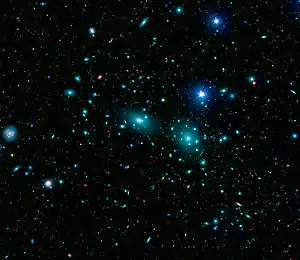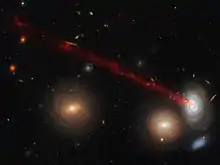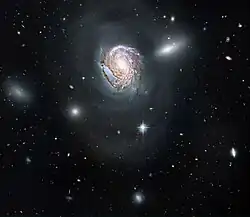Coma Cluster
The Coma Cluster (Abell 1656) is a large cluster of galaxies that contains over 1,000 identified galaxies.[2][3] Along with the Leo Cluster (Abell 1367), it is one of the two major clusters comprising the Coma Supercluster.[8] It is located in and takes its name from the constellation Coma Berenices.
| Coma Cluster | |
|---|---|
 A Sloan Digital Sky Survey/Spitzer Space Telescope mosaic of the Coma Cluster in long-wavelength infrared (red), short-wavelength infrared (green), and visible light. The many faint green smudges are dwarf galaxies in the cluster. | |
| Observation data (Epoch J2000) | |
| Constellation(s) | Coma Berenices |
| Right ascension | 12h 59m 48.7s[1] |
| Declination | +27° 58′ 50″[1] |
| Brightest member | NGC 4874 and NGC 4889 |
| Number of galaxies | > 1000[2][3] |
| Richness class | 2[4] |
| Bautz–Morgan classification | II[4] |
| Velocity dispersion | 1,000 km/s[5] |
| Redshift | 0.0231 (6 925 km/s)[1] |
| Distance | 102.975 Mpc (336 Mly) for h−1 0.705[1] |
| ICM temperature | 8-9 keV[6] |
| Binding mass | ~7×1014[7] M☉ |
| X-ray flux | (319.20 ± 2.6%)×10−12 erg s−1 cm−2[1] (0.1-2.4 keV)[1] |
| Other designations | |
| Abell 1656[1] | |
The cluster's mean distance from Earth is 99 Mpc (321 million light years).[3][9][10] Its ten brightest spiral galaxies have apparent magnitudes of 12–14 that are observable with amateur telescopes larger than 20 cm.[11] The central region is dominated by two supergiant elliptical galaxies: NGC 4874 and NGC 4889.[12] The cluster is within a few degrees of the north galactic pole on the sky. Most of the galaxies that inhabit the central portion of the Coma Cluster are ellipticals. Both dwarf and giant ellipticals are found in abundance in the Coma Cluster.[13]
Cluster members

As is usual for clusters of this richness, the galaxies are overwhelmingly elliptical and S0 galaxies, with only a few spirals of younger age, and many of them probably near the outskirts of the cluster.
The full extent of the cluster was not understood until it was more thoroughly studied in the 1950s by astronomers at Mount Palomar Observatory, although many of the individual galaxies in the cluster had been identified previously.[16][17][18]
Dark matter
The Coma Cluster is one of the first places where observed gravitational anomalies were considered to be indicative of unobserved mass. In 1933 Fritz Zwicky showed that the galaxies of the Coma Cluster were moving too fast for the cluster to be bound together by the visible matter of its galaxies. Though the idea of dark matter would not be accepted for another fifty years, Zwicky wrote that the galaxies must be held together by "dunkle Materie" (dark matter).[19][20]
About 90% of the mass of the Coma cluster is believed to be in the form of dark matter. The distribution of dark matter throughout the cluster, however, is poorly constrained.[21]
X-ray source
An extended X-ray source centered at 1300+28 in the direction of the Coma cluster of galaxies was reported before August 1966.[22] This X-ray observation was performed by balloon, but the source was not detected in the sounding rocket flight launched by the X-ray astronomy group at the Naval Research Laboratory on November 25, 1964.[23] A strong X-ray source was observed by the X-ray observatory satellite Uhuru close to the center of the Coma cluster and this source was suggested to be designated Coma X-1.[24]
The Coma cluster contains about 800 galaxies within a 100 x 100 arc-min area of the celestial sphere. The source near the center at RA (1950) 12h56m ± 2m Dec 28°6' ± 12' has a luminosity Lx = 2.6 x 1044 ergs/s.[24] As the source is extended, with a size of about 45', this argues against the possibility that a single galaxy is responsible for the emission.[24] The Uhuru observations indicated a source strength of no greater than ~10−3 photons cm−2s−1keV−1 at 25 keV,[24] which disagrees with the earlier observations[22] claiming a source strength of ~10−2 photons cm−2s−1keV−1 at 25 keV, and a size of 5°.
Gallery
 Thousands of globular clusters lying at the core of a galaxy cluster.[25]
Thousands of globular clusters lying at the core of a galaxy cluster.[25] A large portion of the Coma Cluster seen by Hubble's Advanced Camera for Surveys
A large portion of the Coma Cluster seen by Hubble's Advanced Camera for Surveys Hubble close-up on the Coma Cluster.[26]
Hubble close-up on the Coma Cluster.[26] A face-on view of a spiral galaxy (NGC 4911) located deep within the Coma Cluster.
A face-on view of a spiral galaxy (NGC 4911) located deep within the Coma Cluster..jpg.webp) Wide field image of the Coma Cluster taken at the Mount Lemmon SkyCenter using the 0.8m Schulman Telescope.
Wide field image of the Coma Cluster taken at the Mount Lemmon SkyCenter using the 0.8m Schulman Telescope. Coma Cluster photographed through 8" Celestron Edge HD in San Diego, CA.[27]
Coma Cluster photographed through 8" Celestron Edge HD in San Diego, CA.[27] Map of the central part of the Coma Cluster.
Map of the central part of the Coma Cluster.
See also
- List of Abell clusters
- List of galaxy groups and clusters
- Eridanus Cluster
- Fornax Cluster – another nearby cluster of galaxies
- Norma Cluster
- Virgo Cluster – another nearby cluster of galaxies
- X-1 X-ray source
References
- "NASA/IPAC Extragalactic Database". Results for Abell 1656. Retrieved 2006-09-19.
- "Chandra/Field Guide to X-ray Sources". Coma Cluster. Archived from the original on April 21, 2008. Retrieved 2008-06-16.
- "NASA / Focus on the Coma Cluster". Archived from the original on 2008-05-30. Retrieved 2008-06-16.
- Abell, George O.; Corwin, Harold G., Jr.; Olowin, Ronald P. (May 1989). "A catalog of rich clusters of galaxies". Astrophysical Journal Supplement Series. 70 (May 1989): 1–138. Bibcode:1989ApJS...70....1A. doi:10.1086/191333. ISSN 0067-0049.
{{cite journal}}: CS1 maint: multiple names: authors list (link) - Struble, Mitchell F.; Rood, Herbert J. (November 1999). "A Compilation of Redshifts and Velocity Dispersions for ACO Clusters". The Astrophysical Journal Supplement Series. Chicago, Illinois, USA: The University of Chicago Press. 125 (1): 35–71. Bibcode:1999ApJS..125...35S. doi:10.1086/313274.
- Section 4 of Sato, Takuya; Matsushita, Kyoko; Ota, Naomi; Sato, Kosuke; Nakazawa, Kazuhiro; Sarazin, Craig L. (November 2011). "Suzaku Observations of Iron K-Lines from the Intracluster Medium of the Coma Cluster" (PDF). Publications of the Astronomical Society of Japan. 63 (SP3): S991–S1007. arXiv:1109.0154. Bibcode:2011PASJ...63S.991S. doi:10.1093/pasj/63.sp3.s991. Retrieved March 12, 2012.
{{cite journal}}: CS1 maint: multiple names: authors list (link) - Gavazzi, R.; Adami, C.; Durret, F.; Cuillandre, J.-C.; Ilbert, O.; Mazure, A.; Pelló, R.; Ulmer, M.P. (May 2009). "A weak lensing study of the Coma cluster". Astronomy and Astrophysics. 498 (2): L33–L36. arXiv:0904.0220. Bibcode:2009A&A...498L..33G. doi:10.1051/0004-6361/200911841. S2CID 15418452.
- "The Coma Supercluster".
- "2MASS Atlas Image Gallery: Galaxy Groups and Clusters". Infrared Processing and Analysis Center. Retrieved 2010-05-02.
- Colless, M (2001). "Coma Cluster". In P Murdin (ed.). Encyclopedia of Astronomy and Astrophysics. Bristol Institute of Physics publishing. Retrieved 2006-10-08.
- Singapore Science Centre. "ScienceNet - Astronomy & Space Science - Observatories/ Telescopes - Question No. 13490". Archived from the original on 2005-11-11. Retrieved 2012-02-25.
- Conselice, Christopher J., Gallagher, John S., III (1998). "Galaxy aggregates in the Coma cluster". Monthly Notices of the Royal Astronomical Society. 297 (2): L34–L38. arXiv:astro-ph/9801160. Bibcode:1998MNRAS.297L..34C. doi:10.1046/j.1365-8711.1998.01717.x. S2CID 14908115.
{{cite journal}}: CS1 maint: multiple names: authors list (link) - Newswise: Hubble's Sweeping View of the Coma Cluster of Galaxies Retrieved on June 11, 2008.
- "Wading through water". www.spacetelescope.org. Retrieved 28 January 2019.
- Cramer, William J.; et al. (Jan 2019). "Spectacular Hubble Space Telescope Observations of the Coma Galaxy D100 and Star Formation in Its Ram Pressure–stripped Tail". The Astrophysical Journal. 870 (2): 2. arXiv:1811.04916. Bibcode:2019ApJ...870...63C. doi:10.3847/1538-4357/aaefff. S2CID 119218554.
- Zwicky, Fritz (October 1937). "On the Masses of Nebulae and of Clusters of Nebulae". Astrophysical Journal. 86 (3): 217–246. Bibcode:1937ApJ....86..217Z. doi:10.1086/143864.
- Shapley, Harlow (July 1934). "A Photometric Investigation of Wolf's Cluster of Nebulae in Coma". Harvard College Observatory Bulletin. Cambridge, MA, USA. 896: 3–12. Bibcode:1934BHarO.896....3S.
- Wallenquist, Å. (1933). "On the space distribution of the nebulae in the Coma Cluster". Annalen V.d. Bosscha-Sterrenwacht (Miscellaneous Papers (Observatorium Bosscha)). France: Bandoeng : Gebrs. Kleijne. 4 (6): 73–77. Bibcode:1933AnBos...4...73W.
- Zwicky, F. (1933). "Die Rotverschiebung von extragalaktischen Nebeln" [The red shift of extragalactic neubulae]. Helvetica Physica Acta (in German). 6: 110–127. Bibcode:1933AcHPh...6..110Z. From p 125: "Um, wie beobachtet, einen mittleren Dopplereffekt von 1000 km/sek oder mehr zu erhalten, müsste also die mittlere Dichte im Comasystem mindestens 400 mal grösser sein als die auf Grund von Beobachtungen an leuchtender Materie abgeleitete. Falls sich dies bewahrheiten sollte, würde sich also das überraschende Resultat ergeben, dass dunkle Materie in sehr viel grösserer Dichte vorhanden ist als leuchtende Materie." (In order to obtain an average Doppler effect of 1000 km/s or more, as observed, the average density in the Coma system would thus have to be at least 400 times greater than that derived on the basis of observations of luminous matter. If this were to be verified, the surprising result would then follow that dark matter is present in very much greater density than luminous matter.)
- de Swart, J. G.; Bertone, G.; van Dongen, J. (2017). "How dark matter came to matter". Nature Astronomy. 1 (59): 0059. arXiv:1703.00013. Bibcode:2017NatAs...1E..59D. doi:10.1038/s41550-017-0059. S2CID 119092226.
- Merritt, D. (February 1987). "The Distribution of Dark Matter in the Coma Cluster". The Astrophysical Journal. 313: 121–135. Bibcode:1987ApJ...313..121M. doi:10.1086/164953.
- Boldt E, McDonald FB, Riegler G, Serlemitsos P (1966). "Extended source of energetic cosmic X rays". Phys. Rev. Lett. 17 (8): 447–50. Bibcode:1966PhRvL..17..447B. doi:10.1103/PhysRevLett.17.447.
- Friedman H, Byram ET (January 1967). "X-rays from the Coma cluster of galaxies". Astrophysical Journal. 147 (1): 399–401. Bibcode:1967ApJ...147..368.. doi:10.1086/149022. S2CID 4286878.
- Gursky H, Kellogg E, Murray S, Leong C, Tananbaum H, Giacconi R (Aug 1971). "A strong X-ray source in the Coma cluster observed by Uhuru". Astrophysical Journal. 167 (8): L81–4. Bibcode:1971ApJ...167L..81G. doi:10.1086/180765.
- "Clusters within clusters". www.spacetelescope.org. Retrieved 3 December 2018.
- "Hubble close-up on the Coma Cluster". ESA/Hubble Picture of the Week. Retrieved 18 January 2014.
- "Coma Cluster".
External links
- The Coma Cluster of Galaxies - Astronomy Picture of the Day, NASA, 2000 August 6
- The clickable Coma galaxy cluster
- The dynamical state of the Coma cluster with XMM-Newton
- Very Small Array observations of the Sunyaev-Zel'dovich effect in nearby galaxy clusters
- Hubble Space Telescope Treasury Survey of the Coma Cluster
- The Coma Cluster on WikiSky: DSS2, SDSS, GALEX, IRAS, Hydrogen α, X-Ray, Astrophoto, Sky Map, Articles and images